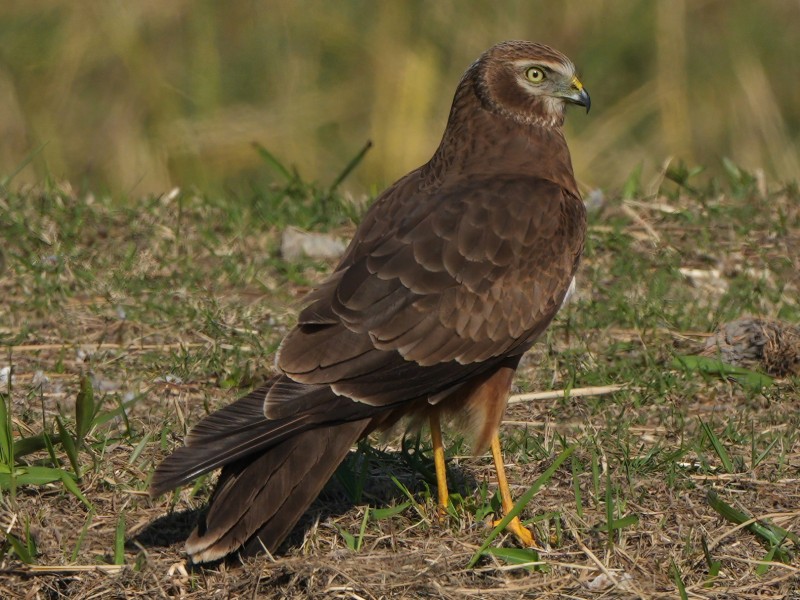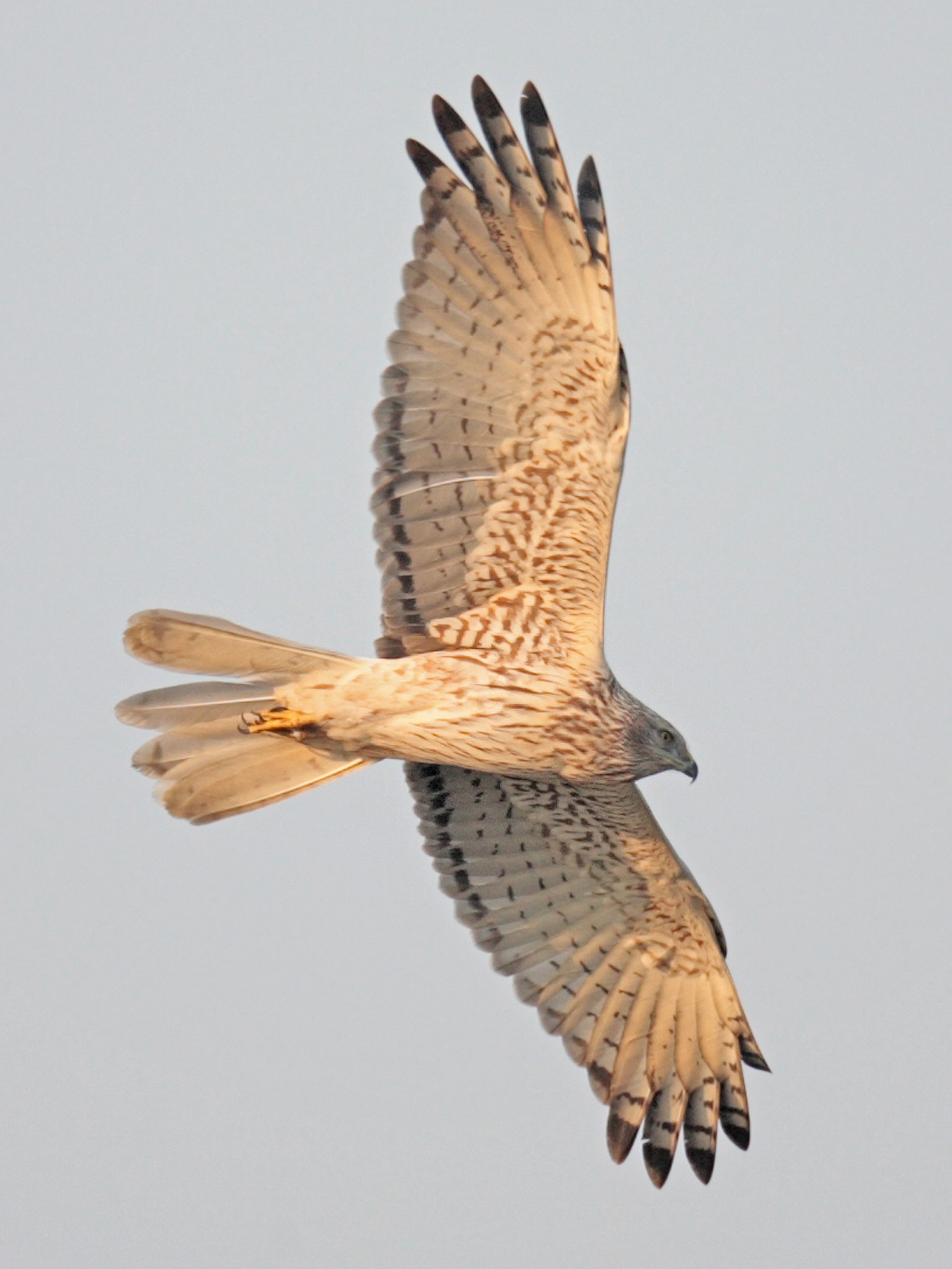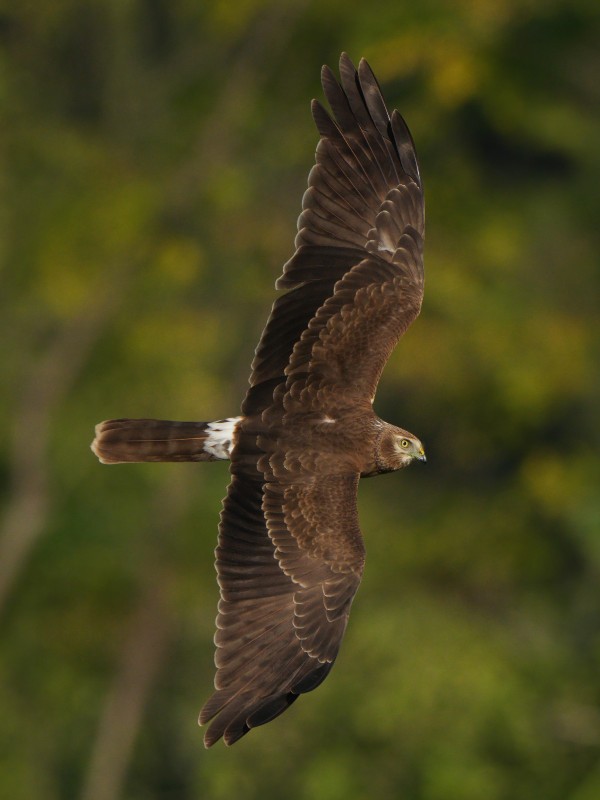Pied Harrier 鵲鷂 Circus melanoleucos
Category I. Common passage migrant in autumn, scarce winter visitor and spring passage migrant. Mainly in Deep Bay area, but scattered records elsewhere.
IDENTIFICATION

Dec. 2022, Paul Leader. Juvenile.
43-50 cm (male notably smaller and leaner than female). Most birds that occur are in juvenile plumage and show warm brown underparts and underwing coverts that contrast with dark secondaries and pale primaries, the latter with irregular greyish bars.

Nov. 2024, Paul Leader. Juvenile.
The upperparts of juveniles are warm brown with pale fringes to scapulars and coverts. The face pattern is relatively plain compared to other harriers, with a broad dark brown crescent of equal emphasis along its length behind and below the eye.

Mar. 2005, Myanmar. John and Jemi Holmes. Adult male.
Adult males are rarely seen in HK, but highly distinctive.

Feb. 2023, Paul Leader. Adult female.
Adult females have dull greyish outer primaries on the upperwing that contrast with greyish inner primaries, secondaries and outer wing coverts; the forewing is brownish with a pale shawl. The outer primaries on the underwing are only slightly darker than the rest of the underwing and the inner primaries lack broad dark tips. The chest and flanks are broadly streaked brown, while the head is finely streaked so. Separated from immature male Eastern Marsh Harrier by obvious whitish shawl over forewing, neat bars on upper side of remiges, barred upper tail and more prominent facial disk (Ayuwat 2022).

Jan. 2009, John and Jemi Holmes. Adult female.
Some adult females are much paler and less streaked on the underwing and underbody.

Jan. 2024, Paul Leader. Juvenile.
The upperparts of juveniles are warm brown with pale fringes to scapulars and coverts and, usually, an obvious white rump.
VOCALISATIONS
Not heard to vocalise in HK.
DISTRIBUTION & HABITAT PREFERENCE
Most records are from wetlands in the Deep Bay area, particularly in the vicinity of Mai Po NR. Several records have occurred at Long Valley, and there are a few from Lantau and one at Lai Chi Wo.
OCCURRENCE
Figure 1 illustrates the pattern of occurrence since the first acceptable record in 1988 and indicates that Pied Harrier is largely a passage migrant in autumn, when the main passage period extends from the final week of September to the third week of November, peaking in the middle two weeks of October. The numbers recorded from the last week of November through to April are broadly similar, with the few records in the second half of February and first week of March perhaps indicating a transition from wintering birds to migrants. Extreme dates are 15 September 2008 and 25 April 2020, while the highest count is five on 11 October 2020.
BEHAVIOUR, FORAGING & DIET
Has been recorded predating Black-winged Stilt and Oriental Reed Warbler. Usually seen quartering wetland habitat in the Deep Bay area, particularly Mai Po NR.
RANGE & SYSTEMATICS
Monotypic. Breeds from northeast Mongolia east through northeast China and adjacent parts of southeast Siberia to Ussuriland; winters from the Indian subcontinent east through Indochina to southwest China and south to southeast Asia, Sumatra, Borneo, the Philippines (Oorta et al. 2020). In China a summer visitor to the northeast and a winter visitor south of the Yangtze (Liu and Chen 2020).
CONSERVATION STATUS
IUCN: Least Concern. Population trend decreasing.
Figure 1.

Ayuwat (2022). Identification of harriers in Thailand. https://ayuwat.blog/2022/03/01/identification-of-harriers-in-thailand/
Liu, Y. and Y.H. Chen (eds) (2020). The CNG Field Guide to the Birds of China (in Chinese). Hunan Science and Technology Publication House, Changsha.
Orta, J., P. F. D. Boesman, and J. S. Marks (2020). Pied Harrier (Circus melanoleucos), version 1.0. In Birds of the World (J. del Hoyo, A. Elliott, J. Sargatal, D. A. Christie, and E. de Juana, Editors). Cornell Lab of Ornithology, Ithaca, NY, USA. https://doi.org/10.2173/bow.piehar1.01

